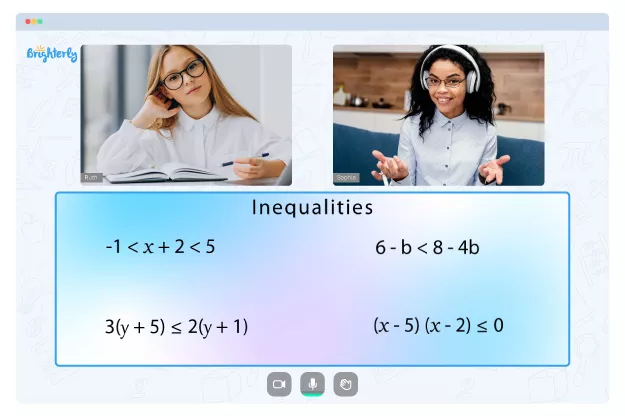Inequality – Definition with Examples
Created on Jan 12, 2024
Updated on January 12, 2024
Inequality is a fundamental concept in mathematics, acting as a building block for many mathematical theories and ideas. Simply put, inequalities describe the relative size or value of two numbers. They tell us if one number is larger, smaller, or equal to another number. For instance, if we have two numbers, say 5 and 7, we can say 5 < 7, indicating that 5 is less than 7.
At Brighterly, we believe in making complex mathematical concepts easily understandable and enjoyable for children. As we delve deeper into the world of inequalities in this comprehensive article, we aim to demystify the rules governing them and provide clear examples to make learning easier for young mathematicians. This guide is designed to be interactive, engaging, and filled with practical examples to bring the concept of inequality to life for your young learner.
Origin of the Term: Inequality
The term “inequality” in mathematics has a rich history, dating back to ancient times. The concept was widely used in the works of legendary mathematicians such as Euclid, who used inequality concepts in his famous work, the “Elements.” Today, inequality is a staple concept in mathematical education, forming the foundation of a myriad of mathematical problems and theories. It also plays a pivotal role in various fields, including statistics, economics, and physics, to name a few.
Rules of Inequalities
Inequalities follow certain rules, also known as properties. Understanding these rules is crucial in order to solve inequality equations correctly. Let’s explore each rule one by one, with simple explanations to help you grasp the concepts.
Inequalities Rule 1
The first rule of inequalities states that if ‘a’ is greater than ‘b’, then ‘a + c’ is greater than ‘b + c’. This means you can add the same number to both sides of an inequality without changing its truth.
Inequalities Rule 2
The second rule implies that if ‘a’ is greater than ‘b’, then ‘a – c’ is greater than ‘b – c’. Similar to Rule 1, we can subtract the same number from both sides of an inequality, preserving the inequality.
Inequalities Rule 3
The third rule of inequalities is a little more complex. It states that if ‘a’ is greater than ‘b’ and ‘c’ is a positive number, then ‘ac’ is greater than ‘bc’. In simpler words, you can multiply both sides of an inequality by a positive number without affecting the inequality.
Inequalities Rule 4
The fourth rule is a caveat to Rule 3. If ‘a’ is greater than ‘b’ and ‘c’ is a negative number, then ‘ac’ is less than ‘bc’. When you multiply both sides of an inequality by a negative number, the inequality sign reverses.
Inequalities Rule 5
The fifth rule states that if ‘a’ is greater than ‘b’ and ‘c’ is a positive number, then ‘a/c’ is greater than ‘b/c’. We can divide both sides of an inequality by the same positive number, and the inequality will remain unchanged.
Inequalities Rule 6
Similar to Rule 4, Rule 6 states that if ‘a’ is greater than ‘b’ and ‘c’ is a negative number, then ‘a/c’ is less than ‘b/c’. This rule reminds us that when we divide both sides of an inequality by a negative number, the inequality sign reverses.
Inequalities Rule 7
The seventh rule suggests that if ‘a’ is greater than ‘b’, then ‘a^2’ is greater than ‘b^2’. This rule applies when both ‘a’ and ‘b’ are greater than zero.
Inequalities Rule 8
The final rule states that if ‘a’ is greater than ‘b’, and both ‘a’ and ‘b’ are greater than zero, then ‘a^n’ is greater than ‘b^n’ for any positive integer ‘n’. This is especially handy when dealing with inequalities involving exponents.
Solving Polynomial Inequalities
Solving polynomial inequalities involves a sequence of steps. After arranging the inequality in standard form and factoring the polynomial, we find the critical values. We then use these values to test the intervals in order to solve the inequality.
Solving Linear Inequalities
Linear inequalities are solved similarly to linear equations, with one key difference – we must remember to reverse the inequality sign when multiplying or dividing by negative numbers.
Solving One Step Inequalities
One-step inequalities are those where only one operation is required to isolate the variable. The operation can be addition, subtraction, multiplication, or division. Remember the rules of inequalities while solving them!
Solving Two Step Inequalities
Two-step inequalities require two operations to isolate the variable. The operations could involve addition or subtraction followed by multiplication or division, or vice versa.
Solving Compound Inequalities
A compound inequality contains at least two inequalities joined by either “and” or “or”. They are solved by solving each inequality separately, then combining the solutions according to the connector (“and”/”or”).
Solving Quadratic Inequalities
Quadratic inequalities can be solved using several methods such as factoring, using the quadratic formula, or graphing. The solutions to a quadratic inequality are intervals of values, not just individual points.
Inequalities Examples
Let’s look at some practical examples to better understand inequalities:
Example 1: One-step inequality Solve the inequality x + 5 > 9. Solution: x > 4.
Example 2: Two-step inequality Solve the inequality 2x + 3 < 7. Solution: x < 2.
Example 3: Compound inequality Solve the inequality 2 < x < 7. Solution: All numbers between 2 and 7 satisfy the inequality.
Example 4: Quadratic inequality Solve the inequality x^2 – 4 > 0. Solution: x > 2 or x < -2.
Practice Questions on Inequalities
It’s time to practice! Here are some questions to test your understanding of inequalities:
- Solve the inequality: 5x + 3 > 8
- Solve the inequality: 3x – 2 < 4
- Solve the compound inequality: 1 < x < 5
- Solve the quadratic inequality: x^2 – 5x + 6 > 0
Conclusion
Inequalities, though seemingly complex at first glance, are a fascinating and integral part of mathematics. They offer us robust tools to express a wide range of mathematical relationships and solve problems that range from the simplest to the most complex. Inequalities form a crucial part of the learning curriculum for students. As students advance in their mathematical journey, they’ll encounter inequalities in various forms and complexities.
At Brighterly, our mission is to ignite the spark of understanding and passion for mathematics in every student. Through our comprehensive, approachable, and engaging guides, we strive to simplify complex concepts, such as inequalities, and make them accessible and enjoyable for young learners.
Frequently Asked Questions on Inequalities
Here are some frequently asked questions about inequalities:
What is an inequality?
An inequality is a mathematical statement that compares two values or expressions. It demonstrates the relationship between these two entities by indicating if one is less than (<), greater than (>), less than or equal to (≤), or greater than or equal to (≥) the other. Inequalities provide a way to represent a range of possible values, rather than a specific value, which an equation might express.
What are the rules of inequalities?
There are eight primary rules, or properties, of inequalities. These rules help us manipulate and solve inequality equations without changing their truth. The rules cover actions such as adding, subtracting, multiplying, or dividing both sides of an inequality, and provide insights about how these operations can change the inequality’s direction. For instance, multiplying or dividing an inequality by a negative number flips the inequality sign, a unique characteristic that differentiates inequalities from equations.
What is a compound inequality?
A compound inequality is an equation with two or more inequalities joined together with the words “and” or “or”. When the inequalities are combined with “and”, it means that both inequalities must be true at the same time. When the inequalities are combined with “or”, it means that at least one of the inequalities must be true. Compound inequalities provide a way to express multiple conditions or constraints simultaneously.
What is the difference between solving equations and inequalities?
Both equations and inequalities involve determining the values that make the statement true. However, the solutions to inequalities aren’t specific values, as in the case of equations, but rather ranges of values. Also, when working with inequalities, special attention must be paid to the direction of the inequality, particularly when multiplying or dividing by a negative number. In such cases, the direction of the inequality changes, which is not a concern when solving equations.
Information Sources
The information in this blog post has been collated from trusted sources such as:




